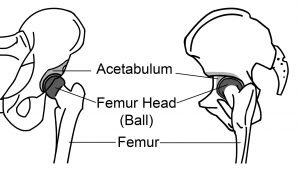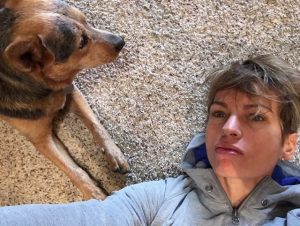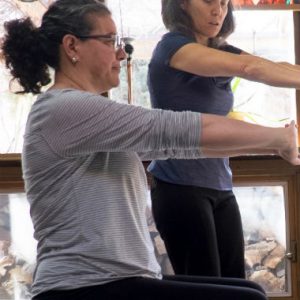Posture Therapy: A Bodyworker's Perspective
May 07, 2019
Last summer, Elizabeth Lamoureux was diagnosed with Femoroacetabular Impingement (FAI) in her right hip. FAI creates abnormal contact and wear in the hip joint, between the ball—top of the femur (thigh bone)—and the socket—acetabulum (depression in the pelvic bone).

This debilitating issue can cause loss of joint range of motion. It also causes changes to the shape of the ball and socket, which was the case for Elizabeth. However, she had many tools at her disposal to aid her healing.
For example, one tool Elizabeth had was that she had been practicing Structural Integration (SI), also known as Rolfing, for 15 years. Additionally, she has been learning and pursuing certification in Biodynamic Cranial Sacral Therapy. She has also been a fitness instructor and personal trainer. Thus, she knows a lot about the body! However, just like many of us, when she heard her diagnosis, she wasn’t sure what to do. So, she consulted with “Dr Google” to find out all she could about her condition. Be honest. Who hasn't done that?
Her first recommendation for treatment came from her orthopedic doctor, who recommended a hip replacement. This surgical first line of treatment is all too common. However, Elizabeth was determined to try less invasive approaches before having surgery. And actually, this issue wasn't brand new. She had suffered for 20 years with chronic pain in her hip that extended up into her lower back. To prevent pain, she had reduced her activities, such as yoga, hiking and mountain biking. Elizabeth was still a young woman, though. She didn’t want to continue down this path of shrinking activities and less movement in her life. So, instead of accepting surgery, she started looking more broadly for alternatives.
In order to heal, she continued treating the soft tissue through bodywork, rolling and yoga. These treatments, though, were not successful. She realized, “You can’t stretch away the shape of the bone.” She then tried the “FAI FIX,” which is an exercise program to help realign, balance and strengthen the hips and surrounding muscles. Although this program did reduce her pain, it only took her so far. She stopped improving.
The problem, as she saw it, was the FAI FIX exercises were only addressing her lower body—pelvis to knee. Because of her knowledge as a bodyworker, she knew this was incomplete. This understanding caused her to look for a whole-body approach. She wanted something that treated all the interconnected systems. As she put it, “You can’t take parts out of the whole.” She wanted an approach that looked at the relationships between the parts of the body, like she does through her work with SI. She searched for something that takes into account movement patterns.
What she had been doing was compartmentalized. She had been treating one area or symptom at a time. She could feel the results of her hip pain and compensated movements throughout her body. As a result of these imbalanced movements, Elizabeth now developed pain in her left knee and right ankle. And, she knew those needed to be dealt with for her to fully recover. An integrated approach was necessary, but she didn’t know where to find it.
A year before, she had attended a local Posture Fitness class and found the information taught valuable and complimentary to her work. Busy with life, though, she hadn’t returned. However, she remembered it when the instructor (me) booked an SI session with her last fall. We decided to do a trade for services since there seemed to be mutual need and potential benefit.
We started Elizabeth’s posture therapy session with a detailed wellness discussion. Then, we moved into a posture assessment: I took four posture pictures and conducted a hands-on analysis of bone position. It was then that I found upper and lower body misalignments. So, although her symptom, FAI, was in the lower body, I treated her whole body. It may not seem important, but the upper body's position directly affects the alignment and function of the lower body. Everything is connected!
In Elizabeth’s words, “Posture work is not about the place of pain, but rather how the system works as a whole.”
Not surprisingly, Elizabeth had misalignments in her pelvis. This is often true with hip conditions. Her right hip was higher than the left and rotated forward. When the pelvis changes position, the hip can also move in the socket. In this position, Elizabeth physically experienced tension along her entire spine. Her lower back and neck felt overused and strained. Mentally, she felt less grounded and lacked presence in the current moment.

Elizabeth doing one of her posture exercises. Her dog, Stanley accompanies her.[/caption]
Posture therapy uses exercises to realign the body. After performing a few movements, Elizabeth’s pelvis came back into balance. Consequently, the strain in her lower back eased, her shoulders relaxed, and weight in her feet became soft and stable. Additionally, her mood and outlook improved, breathing became easier, and she felt more relaxed and patient.
“I can do this work myself. It is empowering and gives me confidence knowing that I don’t have to stay in a crooked, painful body. I have the tools to daily hit reset on my position and dysfunctional patterns and movements. This reduces my fear. My pain no longer controls my ability to do the activities that I love.”
At the conclusion of her posture therapy session, Elizabeth was given a list of daily exercises including pictures, descriptions and videos. Being human, there were days when her mind created many excuses not to do the program, but she did them anyway. She had made a commitment. And, every time she started, it felt like a big exhale of tension. She said it felt really good. The progress was validating, and she began to look forward to doing the exercises because they were helping her so much. The program has become such an integral part of her day that if she doesn’t do it, she feels something is missing and is uncomfortable at the mind-body-spirit level.
Through the process, she became highly aware of what her body needs day to day. Sometimes she needed a gentle neurological shift with more passive positions and breathing, while at other times, she needed more active and challenging exercises. She realized, “Posture therapy has taught me how to sense these different needs and provided me with the tools and process to address them.”
Before, she was limited in her activities. Now, as a result of these exercises, Elizabeth is gradually incorporating more hiking and movement into her life. She reflects on this. “I fully feel like I am getting my life back bit by bit. It is astounding to think about where I was a year ago.”
Through her experience as a client, Elizabeth more fully realizes how SI and posture therapy go hand-in-hand. Similar to SI, posture therapy works with gravity, treats the body as a whole, and practices balanced, reciprocal movement. Both approaches create space in the body to allow effortless movement. Posture therapy provides the framework for our bodies to move in efficient, pain-free patterns. As Elizabeth says, “SI has made moving differently possible, and posture therapy is the practice of these new potentials.”
____________________________________________________________________________________________
Special thanks to Elizabeth Lamoureux for her collaboration on this article. She practices in Moab, UT and can be reached at 435-260-1320 for Structural Integration and Biodynamic Cranial Sacral appointments.
____________________________________________________________________________________________

Overcoming Barriers to Posture Therapy
Most people don't know about posture therapy, which makes it more difficult to try. However, the first Egoscue Method© clinic was opened 40 years ago in 1979. Much more than sitting up straight, posture therapy addresses the position of each joint and how joints interact with each other. Some of the exercises are static, easy positions, while others are quite challenging, even for the very fit. Once compensation patterns are eliminated, it can be difficult to perform even simple movements. As an example, there is a story of professional football players being brought to tears just by doing basic arm circles.
Posture therapy is exercise based and does require a commitment of time and energy. However, for me, Elizabeth and my clients, it is worth it so we can do the activities that bring us joy. Additionally, we experience greater body confidence and resilience. If you are doing stretches and exercises now, ask yourself: are they working? Wouldn’t it be nice to know you are doing what your body needs? Start today by taking advantage of the special offer below.
SPECIAL OFFER
30% Off one posture therapy session (in-person or Skype) though May 31, 2019. Call 505.412.3132 or email [email protected] to schedule. Although you need to schedule the appointments during May, you can perform them in a later month. Free consultations also available.
Stay connected with news and updates!
Join our mailing list to receive the latest news and updates from me.
Don't worry, your information will not be shared.
We hate SPAM. We will never sell your information, for any reason.

